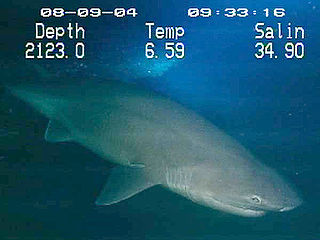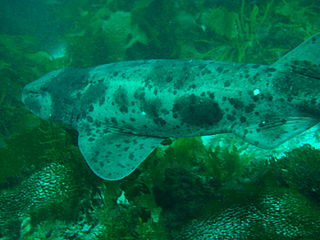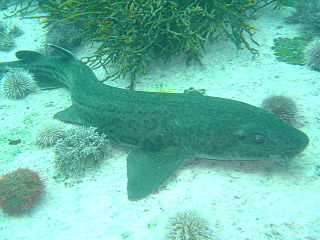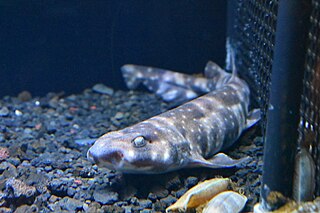
Catsharks are ground sharks of the family Scyliorhinidae. They are the largest family of sharks with around 160 species placed in 17 genera. Although they are generally known as catsharks, some species can also be called dogfish due to previous naming. However, a dogfish may generally be distinguished from a catshark as catsharks lay eggs while dogfish have live young. Like most bottom feeders, catsharks feed on benthic invertebrates and smaller fish. They are not harmful to humans. The family is paraphyletic, containing several distinct lineages that do not form a monophyletic group.

The Hexanchiformes are the order consisting of the most primitive types of sharks, and numbering just seven extant species. Fossil sharks that were apparently very similar to modern sevengill species are known from Jurassic specimens.

The Lamniformes are an order of sharks commonly known as mackerel sharks. It includes some of the most familiar species of sharks, such as the great white, as well as more unusual representatives, such as the goblin shark and megamouth shark.

Cow sharks are a shark family, the Hexanchidae, characterized by an additional pair or pairs of gill slits. Its 37 species are placed within the 10 genera: Gladioserratus, Heptranchias, Hexanchus, Notidanodon, Notorynchus, Pachyhexanchus, Paraheptranchias, Pseudonotidanus, Welcommia, and Weltonia.

Cephaloscyllium is a genus of catsharks, and part of the family Scyliorhinidae, commonly known as swellsharks because of their ability to inflate their bodies with water or air as a defense against predators. These sluggish, bottom-dwelling sharks are found widely in the tropical and temperate coastal waters of the Indian and Pacific Oceans. They have stocky, spindle-shaped bodies and short, broad, and flattened heads. The mouth is capacious, containing many small teeth and lacking furrows at the corners. The two dorsal fins are placed far back on the body, with the first much larger than the second. Different species have various color patterns of saddles, blotches, reticulations, and/or spots. The largest members of the genus can grow over 1 m (3.3 ft) in length. Swellsharks prey on a variety of fishes and invertebrates, and are oviparous, with females producing egg capsules in pairs. They are harmless and have been deemed of having no commercial value.

Parmaturus is a genus of catsharks in the family Scyliorhinidae. Four species were described in 2007 and another in 2019 with more species likely to be described in the near future.

Galeus is a genus of catshark, belonging to the family Scyliorhinidae, commonly known as sawtail catsharks in reference to a distinctive saw-toothed crest of enlarged dermal denticles, found along the upper edges of their caudal fins. They are found in the Atlantic, the western and central Pacific, and the Gulf of California, inhabiting deep waters at or close to the sea floor. Members of this genus are rather small, slim sharks with firm bodies and thick, rough skin. Their heads are usually fairly long and pointed, and have large mouths with well-developed furrows at the corners. They have large pectoral and anal fins, and two similar dorsal fins placed well back. Many species are ornately patterned with dark saddles and/or blotches. Sawtail catsharks feed on various invertebrates and fishes, and may be either egg-laying or live-bearing. These harmless sharks are sometimes caught as bycatch but are of minimal commercial value.

The lollipop catshark is a little-known species of deep sea catshark, belonging to the family Scyliorhinidae, and the only described member of its genus. A diminutive, bottom-dwelling shark of the outer continental shelf and upper continental slope, this species can be readily identified by its tadpole-like shape with a greatly expanded, rounded head and narrow body. The large head houses expanded gills, which are thought to be an adaptation for hypoxic conditions. This shark preys on crustaceans and fishes. Reproduction is aplacental viviparous, with females retaining egg cases internally two at a time until they hatch. There is no fishery interest in this species.

The blotchy swellshark, or Japanese swellshark, is a common species of catshark, belonging to the family Scyliorhinidae. The Blotchy swellshark is found at depths of 90–200 m (300–660 ft) in the northwestern Pacific Ocean, from Japan to Taiwan. It is benthic in nature and favors rocky reefs. Reaching 1.4 m (4.6 ft) in length, this thick-bodied shark has a broad head, large mouth, and two unequally-sized dorsal fins positioned far back past the pelvic fins. It can be identified by its dorsal coloration, consisting of seven brown "saddles" and extensive darker mottling on a light tan background. This species has often been confounded with the draughtsboard shark and the Sarawak pygmy swellshark in scientific literature.

The leopard catshark is a species of catshark, and part of the family Scyliorhinidae, endemic to the coastal waters of South Africa. Abundant in inshore waters under 20 m (66 ft) deep, this bottom-dweller favors rocky reefs, kelp beds, and sandy flats. Growing to a length of 84 cm (33 in), the leopard catshark has a stout body with two dorsal fins placed well back, and a short head and tail. It is extremely variable in color and pattern, with individuals ranging from almost white to black and covered by diverse patterns of black spots, blotches, rosettes, and/or lines. The color pattern changes with age and some forms seem to be location-specific, suggesting the presence of multiple distinct, local populations. In the past, some of the more distinct color forms have been described as different species.

The small-spotted catshark, also known as the sandy dogfish, lesser-spotted dogfish, rough-hound or morgay, is a catshark of the family Scyliorhinidae. It is found on the continental shelves and the uppermost continental slopes off the coasts of Norway and the British Isles south to Senegal and in the Mediterranean, between latitudes 63° N and 12° N. It can grow up to a length of 1 m, and it can weigh more than 2 kg (4.4 lb). It is found primarily over sandy, gravelly, or muddy bottoms from depths of a few metres down to 400 m (1,300 ft). S. canicula is one of the most abundant elasmobranchs in the northeast Atlantic and Mediterranean Sea. The majority of the populations are stable in most areas.

The blackmouth catshark is a species of catshark, and part of the family Scyliorhinidae, common in the northeastern Atlantic Ocean from Iceland to Senegal, including the Mediterranean Sea. It is typically found over the continental slope at depths of 150–1,400 m (490–4,590 ft), on or near muddy bottoms. The youngest sharks generally inhabit shallower water than the older juveniles and adults. This slim-bodied species is characterized by the black interior of its mouth, a marbled pattern of pale-edged brownish saddles or blotches along its back and tail, and a prominent saw-toothed crest of enlarged dermal denticles along the upper edge of its caudal fin. It reaches lengths of 50–79 cm (20–31 in), with sharks in the Atlantic growing larger than those in the Mediterranean.

Rhinobatos is a genus of fish in the Rhinobatidae family. Although previously used to encompass all guitarfishes, it was found to be polyphyletic, and recent authorities have transferred many species included in the genus to Acroteriobatus, Glaucostegus, and Pseudobatos.
The dark freckled catshark is a catshark of the family Scyliorhinidae. It is found in Northeastern and Southeastern Brazil. This species differs from Scyliorhinus besnardi, Scyliorhinus haeckelii group and Scyliorhinus hesperius, in background coloration, head width, sexual maturity, and in cranial and body proportions.
Scyliorhinus cabofriensis is a species of catshark of the family Scyliorhinidae. It is found in Cabo Frio, Rio de Janeiro southeastern Brazil. This species is distinguished from all southwestern Atlantic congeners by its color pattern, clasper and neurocranial morphology and proportional measurements.

Sclerorhynchoidei is an extinct suborder of rajiform rays that had long rostra with large denticles similar to sawfishes and sawsharks. This feature was convergently evolved and their closest living relatives are actually skates. While they are often called "sawfishes", sawskates is a more accurate common name for sclerorhynchoids. The suborder contains five named families: Ganopristidae, Ischyrhizidae, Onchopristidae, Ptychotrygonidae, and Schizorhizidae. Several genera are not currently placed in any of these families. Sclerorhynchoids first appeared in the Barremian and went extinct during the Cretaceous–Paleogene extinction event, with former Paleocene occurrences being misidentifications or reworked specimens.

The cinder cloudy catshark is a species of catshark from the Pacific Ocean; all specimens identified have been from the area around the Izu Islands, Japan. The species is a close relative of the cloudy catshark, and the overall appearance is similar. The species was first identified in 2022 as bycatch of the splendid alfonsino fishery.

The Brazilian filetail catshark is a species of catshark of the family Schyliorhinidae, found in southern Brazil. It lives on the continental slopes at the depths of 500–600 m (1,600–2,000 ft).
















